Saluki S3302 series handheld spectrum analyzer has a variety of measurement functions. In this section, we mainly describe how to use the spectrum analyzer to measure the pulse RF signal.
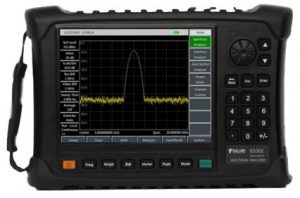
Fig.1 S3302 handheld spectrum analyzer
1. Definition of Pulse RF Signal
The pulse RF signal refers to a RF pulse string of the same repetition frequency and constant pulse width, shape and amplitude. This section introduces several methods of measuring pulse RF signal parameters, including how to measure the center frequency, pulse width and pulse repetition frequency. In addition, the measurement of peak pulse power is also discussed.
The resolution bandwidth has great influence on pulse RF signal measurement. You must understand the relationship between the resolution bandwidth and pulse repetition frequency. If the resolution bandwidth is narrower than the pulse repetition frequency, only individual frequency components of the pulse RF signal will appear on the screen. This is known as the narrow band mode. The mode in which the resolution bandwidth is broader than the pulse repetition frequency is known as the broad band mode. In this case, you can see the spectrum envelope formed by pulse segments that are equalized by the tested pulse repetition frequency.
2. Center Frequency, Side Lobe Ratio and Pulse Width Measurement of Pulse RF Signal
(a) Set the output signal of the signal generator:
Set the frequency of the signal generator as 1GHz and power as -20dBm. Connect the output of the signal generator to the input port of the spectrum analyzer. Set the repetition frequency of pulse modulation as 1kHz and pulse width as 900ns. Enable the pulse modulation and RF output.
(b) Set the output signal of the signal generator:
The pulse RF signal is generally measured in the broad band mode. In order to prevent the influence of the video filter on measurement results, the video bandwidth should be set as 3MHz.
Press [Preset] key.
Press [Freq], [Center Frequency] and 1[GHz].
Press [Freq], [Span], 10[MHz], [Sweep], [Sweep Time Auto Man] and 60[ms].
Press [BW], [RBW Auto Man], 100 [kHz], [VBW Auto Man] and 100 [kHz].
Press [BW], [Detector] and [Peak] to activate the peak detector.
Enable the center frequency function and adjust the span until the center side lobe and at least one pair of side lobes appear on the screen, as shown in Fig.2
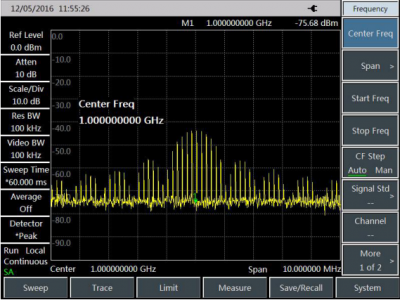
Increase the sweep time (decrease the sweeping speed) until the graph is filled into a solid line, as shown in Fig. 3. If the spectrum line cannot be filled, it indicates that the instrument is not in the broad band mode. In this case, the following steps of measurement of the sidelobe ratio, pulse width and peak pulse power will not apply. The resolution bandwidth should be more than 1kHz.
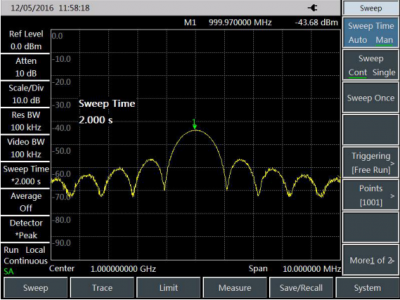
Fig.3 Trace display in solid line form
(c) Read the center frequency of the pulse and amplitude of the main lobe.
Press [Peak].
The marker reading is the center frequency of the pulse and amplitude of the main lobe.
(d) Set the marker at the center frequency of the main lobe, and measure the side lobe ratio:
Press [Peak], [Maker], [Delta], [Peak] and [Next Peak].
The amplitude difference between the main lobe and side lobe is the side lobe ratio, as shown in Fig.4.
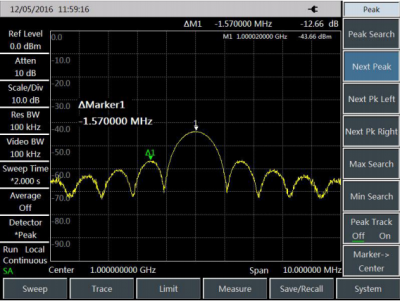
Fig.4 Side lobe ratio shown by the marker
(e) Measure the pulse width, which is equal to the reciprocal of the frequency difference between the peaks of two side lobe envelopes.
Press [Maker], [Delta], [Peak], [Next Pk Right] and [Next Pk Right].
In this case, the reciprocal of the frequency difference indicated by the differential marker is the pulse width, as shown in Fig.5. To obtain the most accurate pulse width, you can manually adjust the marker location and measure the distance between the zero crossing points of two adjacent side lobes. You can also reduce the resolution bandwidth to make the zero crossing point sharper and measurement accuracy higher.
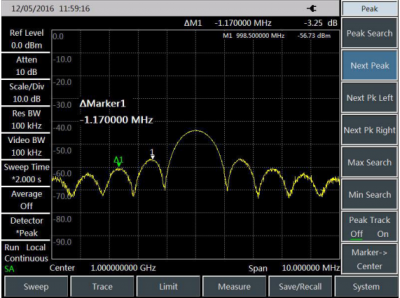
Fig.5 Pulse width shown by the marker



